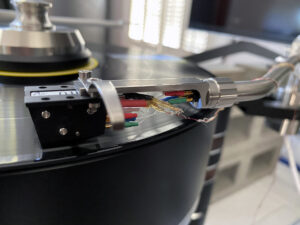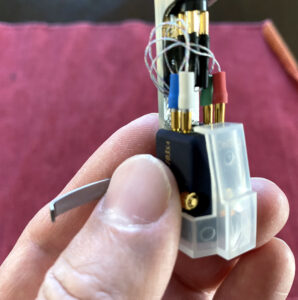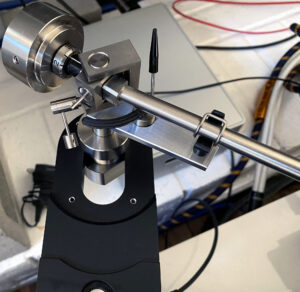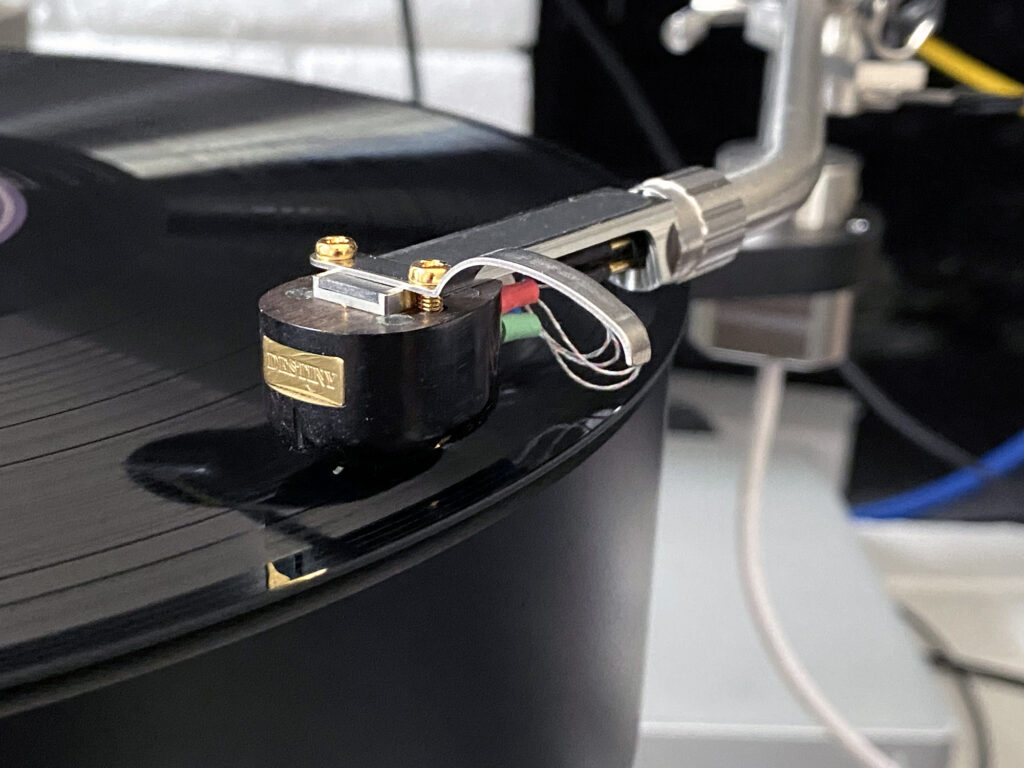Mounting the MH-1200S was straightforward, especially with the Clearaudio Master Innovation turntable system. Clearaudio is able to supply custom armboards, and the Glanz’s 16mm inner shaft fitted one of the three pre-existing Clearaudio armboards. VTA adjustment is a slow process that involves loosening the arm via a screw, holding it at the desired level and tightening the screw again. There is no provision for azimuth adjustment. Aftermarket tools like spacers, or cartridges with pre-threaded screw holes will facilitate azimuth fine-tuning.
The Ortofon Meister Silver G MkII SPU came my way by serendipity around the same time just as Rick suggested the Glanz MH-1200S. Thus, it was with the Ortofon that I began the audition and review of the tonearm. The Ortofon SPU is essentially a one-piece headshell and cartridge construct, utilizing the standard four-pin connection to a socket on the tonearm, a different design from the Oracle SME 345’s proprietary detachable headshell system otherwise incompatible with the Ortofon SPU. The Ortofon SPU was first auditioned on a Groovemaster tonearm on loan locally, mounted on the Clearaudio Master Innovation turntable system. The result was underwhelming and not involving. The Glanz completely brought the Ortofon SPU into considerable focus and superior tonal vividness. With the Glanz, I understood the Ortofon SPU craze bewitching so many fine ears, and I am now among them.
But the Ortofon SPU is not a modernistic cartridge and unsuitable to be used as a reviewer’s reference cartridge. That accolade falls to the Top Wing Suzaku, which by a freak incompatibility of design is completely unsuitable to be used with the Glanz, due to a persisting, loud hum. Rick suggested complete removal of all grounding scheme and I tried to no avail; I suspect somewhere there is still an intentionally thorough ground connection built-in in-chain what with the PS Audio DirectStream Power Plant 20 AC Regenerator and all source equipment including the turntable drawing power from it. The AMG 12J2 on the third arm tower of the turntable remains the reference tonearm for use with the Suzaku.
The next reference cartridge down that I had on hand was the recently reviewed Miyajima Destiny, running noiselessly and serenely with the Glanz. I had also mounted the Miyajima onto the excellent AMG 12J2, a seriously streamlined design that challenges the imagination. The AMG proved itself to be on par with the Miyajima despite costing a mere 60% of the cartridge, rendering extended responses and a pure midrange sublime and inviting. But the Glanz let through even more dynamic contrasting and dimensionality, and for that the Glanz is indispensable.
Next cartridge down was the Soundsmith Paua II, featuring a long body with the pins stretching out in such proximity that the AMG could barely accommodate. But the Glanz featured an exceptionally long headshell and now the leads are given space to route to the Paua II pins. Kudos to Mr. Hamada. I have yet to see another tonearm with comparably long headshell. What foresight! This is an excellent example of Hamada showing remarkable hindsight drawn from his considerable, past endeavors.
The greatest experience of the Glanz came in the form of the $20,000 Audio Note IO LTD field-coil cartridge system. The IO LTD has six pins, four for the regular left and right, plus an extra two for the left and right field-coil power supply for which the particular $13,000 AN-1S six-wire tonearm variant was custom equipped. Peter Qvortrup of Audio Note UK couldn’t ascertain the compatibility of the Glanz for the heftiness of the 19 grams cartridge, but I went ahead anyway and found the Glanz comfortably accommodating. John McDonald of Audience, along with Dr. Ducote, his chief engineer, presented the finishing piece to the puzzle by providing custom field-coil power supply cables within two weeks from ordering to arrival. The Glanz/Audience system satiated the emotional and rational aspects of my palate mesmerizingly.
Throughout the auditioning, the Glanz’s openness, dimensionality, dynamics and extensions was on full display. Most notably, the roundness of instrumental tonality and glow of tone of the Ortofon Meister Silver G MkII was more than convincing on the Glanz, casting striking contrasting of dynamics between instruments otherwise less descriptive on the Groovemaster. The Groovemaster being less than a fourth of the price of the Glanz got everything right but it was the last additional 5 to 10% increase in focus, realism and vividness via Glanz that imparted the true intrinsic beauty of the Ortofon SPU sound and method that is unique and exclusive. There was almost no high-end aspirations to the SPU sound but a subliminal appeal to the part of the brain that yearns for comfort and serenity. The Glanz MH-1200S was indispensable for the SPU experience.
The Audio Note UK IO LTD sound was quite another level with the Glanz/Audience package, although the Glanz’s incompatibility with the Top Wing Suzaku, my reigning reference to this point, negated the auditioning or I would’ve been able to delineate precisely the point of departure between the two top-billing designs. The Glanz’s openness represents a thrillingly proficient hand for its vibration mitigation techniques that accommodates even a cartridge more than twice its price, specifically in the $20,000 range. Products such as these in these rarefied price points are far and few in between and I can’t begin to fathom what the $24k Premium Glanz model with carbon fiber in its construction would sound like.
Audio technologies are at their most mature states than ever before. The birthright of a high-end tonearm becomes apparent when progressively higher-end cartridges are paced through them with success. One such example is the AMG 12J2, which surpasses even the Oracle SME 345 in keeping pace with cartridges from the $7,600 Miyajima Destiny to the $16,500 Top Wing Suzaku. The Top Wing incompatibility aside, the Glanz’s precision-fitted, stainless steel structures must be given merit in its ability to set cartridges of various standings apart at once and run with the best.
In closing, I am impressed by Hamada and company’s fastidiousness in creating what is ultimately an artistic object of desire. And I quote: “There are many technicians who are aware of distorted sounds and they produce [pure-sounding] equipment but then end up withdrawing it immediately from the market. As the sound becomes clearer, the distortion of the peripheral devices becomes more apparent, so they withdraw [their designs] … because they are sometimes criticized for having bad products. I would like to argue that if we face up squarely to the issues I have already explained, and yet still do not pursue ‘original sound,’ then I believe we have made no progress in electronic acoustics.”
Copy editor: Dan Rubin
- ← Previous page
- (Page 2 of 2)





There is a tiny screw at the underside of the armtube behind the SME collar which can be loosened so that the collar can be rotated to allow azimuth alignment.